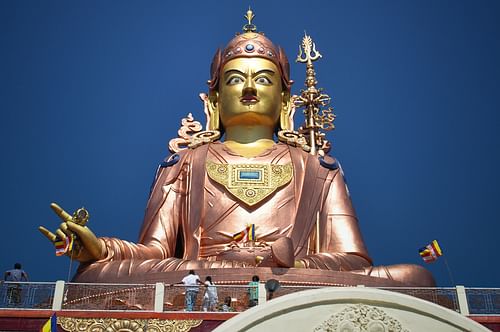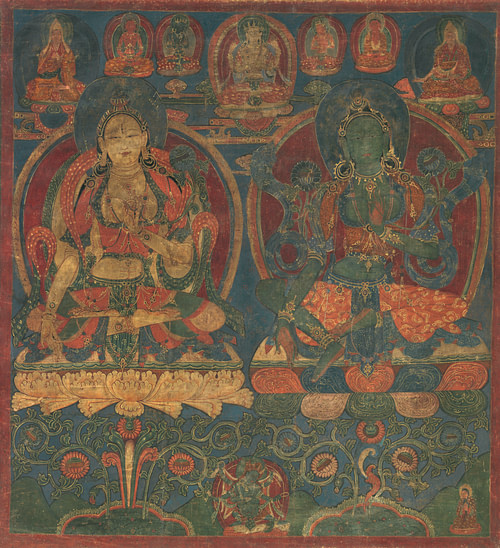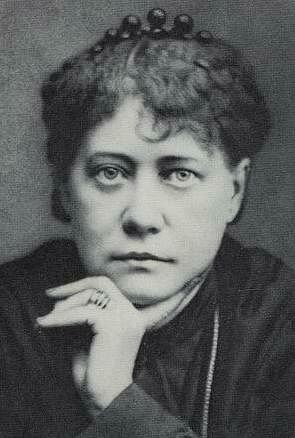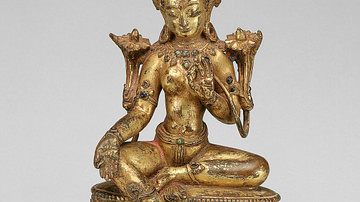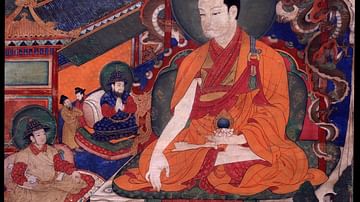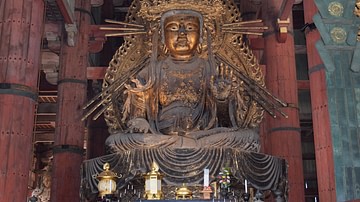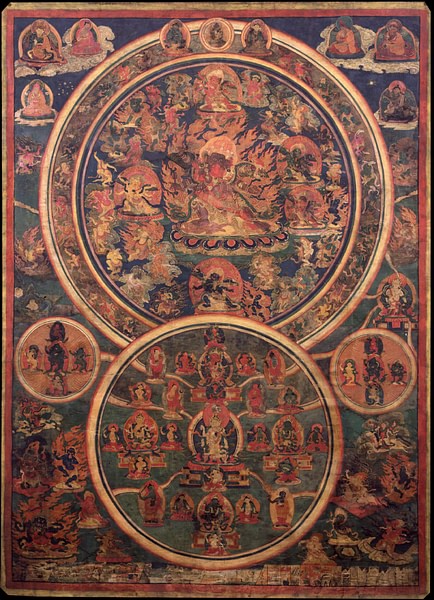
The Tibetan Book of the Dead is the English translation of the Tibetan texts known as bar-do thos-grol (Bardo Thodol) – “Liberation Through Hearing During the Intermediate State” – and serves as a guide for the soul of the deceased after it has left the body and before it is reborn.
The texts were first written in the 8th century CE, discovered in the 14th, and translated into English in the 20th century by the American scholar and anthropologist Walter Evans-Wentz (l. 1878-1965), who was also a spiritualist. Evans-Wentz’s translation became the standard English version most people in the modern day are familiar with and the one other English-speaking authors usually draw from.
Evan Wentz’s Theosophical understanding of the work, supported by the Swiss psychiatrist and analyst Carl Gustav Jung (l. 1875-1961), has established the book as a popular guide in self-transformation, in recognizing the illusory nature of existence, used to free oneself from misconceptions which keep one bound to repetitious cycles of self-destructive or self-limiting behavior. This was not, however, the original purpose of the work.
The Bardo Thodol was written to be read to the spirit of the deceased in the intermediate state (bardo) between the moment the soul left the body and the time it was either reborn in another form or liberated from the cycle of rebirth and death (samsara). When one died, it was believed, one was confronted by the deeds one had done in life personified in the forms of wrathful and peaceful entities. These would be frightening to the soul and so a lama (Tibetan Buddhist monk) would read the Bardo Thodol aloud to let the soul know what it was encountering, and this understanding would enable a more peaceful transition through the intermediate state to a new form of being.
Even so, The Tibetan Book of the Dead as a guidebook for the living has taken on its own life and purpose independent of the original intention. The work, no matter how one interprets it, depends on the recognition of the soul’s survival of bodily death and offers comfort in the promise of continued existence. It is sometimes used in the present day by Hospice workers to calm the fears of the dying and direct them in letting go of their present life to embrace a new experience, addressing the age-old terror of non-existence at death.
History of the Text
According to legend, the Bardo Thodol originated in the 8th century when the Lotus Guru Padmasambhava was invited to Tibet by the emperor Trisong Detsen (r. 755 - c. 797) who required his help in ridding the land of dark spirits that were preventing an acceptance of Buddhist doctrine. Padmasambhava subdued these spirits and transformed them from selfish, fearful, obstructions to guardians of the cosmic law of Dharma, freeing the land from the darkness of ignorance and allowing for the spread of Buddhist enlightenment.
Among the first to respond to the Buddhist message was Yeshe Tsogyal (l. mid 8th century), either principal wife or a consort of Trisong Detsen. She may have been an early devotee of the goddess Tara, a principal deity in the Esoteric Buddhism of Padmasambhava, who inspired women to seek enlightenment and encouraged equality of the sexes. Yeshe Tsogyal, often referred to as the Mother of Tibetan Buddhism, studied dutifully with Padmasambhava, attained enlightenment, and helped him to write the texts which they then concealed in various locations to be found later by those who would reveal them when they were needed.
In the 14th century, the texts were discovered by Karma Lingpa (l. 1326-1386), considered the reincarnation of one of Padmasambhava’s disciples, who was a gter-ston (also given as terton), a “revealer” of the spiritual treasures of the past. Karma Lingpa discovered several texts, not just the Bardo Thodol, as noted by scholar Bryan J. Cuevas:
These were Karma Lingpa’s textual revelations, commonly referred to collectively as the Karling Peaceful and Wrathful: a large literary cycle entitled Self-Liberated Wisdom of the Peaceful and Wrathful Deities and a smaller set of funerary texts called Great Liberation upon Hearing in the Bardo. (17)
These texts were taught by masters to students orally into the 15th century and passed between students in the same way. Cuevas notes how “transmission of religious knowledge, whether in the form of texts or direct oral instruction, was actually a rather fluid process in Tibet” at this time and earlier (19). The texts were not printed until the 18th century when they began to circulate more widely.
In 1919, the British officer Major W. L. Campbell, stationed in Sikkim, India, was traveling in Tibet and purchased a number of these block print manuscripts. Campbell had an interest in Tibetan Buddhism and after his return to Sikkim, he shared them with Dr. Walter Evans-Wentz, an anthropologist in the region studying the religious and spiritual aspects of the culture. Evans-Wentz had a very poor command of the language of the texts and so enlisted the help of Lama Kazi Dawa Samdup (l. 1868-1922) who was headmaster and teacher at a local school.
Dawa Samdup already had an impressive reputation as a translator as he had worked with the famous travel writer and spiritualist Alexandra David-Neel (l. 1868-1969) translating Tibetan into English. He agreed to help Evans-Wentz with the manuscripts, and they met together to translate and interpret the texts until Dawa Samdup’s death in 1922. At this point, only the funerary text of the Bardo Thodol was mostly translated and Evans-Wentz filled in the missing parts with his own interpretation and published it in 1927 under the title The Tibetan Book of the Dead to resonate with the title of The Egyptian Book of the Dead first published in English in 1867 through the British Museum. Since its 1927 publication, The Tibetan Book of the Dead has not only remained in print but has inspired other translations and hundreds of pages of articles and commentary.
The Bardo Thodol
Underlying the vision of the Bardo Thodol is the Buddhist understanding of the interconnectedness of all things and life as a constant cycle of change and impermanence. All things come into being and pass away according to their nature and human suffering arises from trying to maintain permanent states of being in a world of impermanence. The scholar Fung Kei Cheng elaborates:
For Buddhists, life is considered to be not only a process but, more importantly, a "vast process of becoming" with an unceasing cycle of living and dying, implying that individuals experience death innumerable times…Depending on the individual response to reality, it becomes possible to transcend suffering and subdue death anxiety, when a person successfully searches for meaning in life and subsequently prepares to die well through letting go of death. (68-69)
One’s response to reality in life is thought to shape one’s experiences after death. If one has devoted oneself to elevated thought and action, one might expect to encounter only peaceful entities on the other side, but human beings are flawed and even the most devout spiritual person will experience lapses, negative thoughts and feelings, and dark times when they are separated from their higher power.
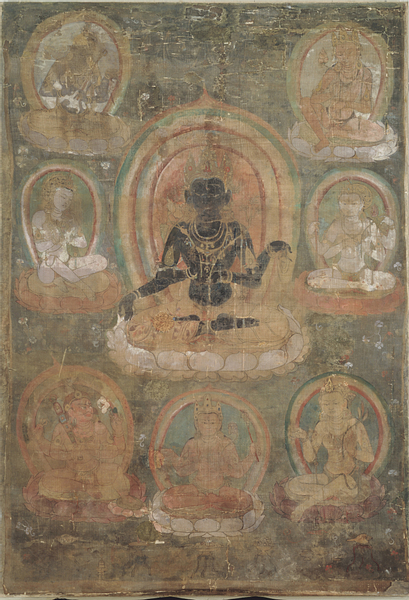
In the afterlife, both the positive (peaceful) and the negative (wrathful) energies of one’s life are manifested as entities trying to block or open one’s path through the intermediate state. The Bardo Thodol is read to the soul to let it know what it is encountering and what to expect next.
There are six sections to the text, each addressing a different state within the larger intermediate state:
- Reminder of the Bardo of Reality-Itself
- Root Verses on the Six Bardos
- Religious Liturgy of the Self-Liberation of Karmic Latencies
- Self-Liberated Vision: A Prayer to the Five Pure Lands
- Direct Introduction to the Bardo of Becoming
- Prayer Requesting Assistance from the Buddhas and Bodhisattvas of the Ten Directions
(Cuevas, 174)
In the first bardo, one experiences the moment of death and passes to the "clear light seen at the moment of death" which is reality itself, not the illusion of reality one experienced on earth.
In the second bardo, one is introduced to an overview of all six bardos and the Buddha forms that may manifest as well as other entities.
In the third bardo, one experiences the personifications of one’s sins and good deeds in life as sometimes frightening hallucinations which, if one recognizes them for what they are, one may pass through toward rebirth or liberation.
In the fourth bardo, one frees oneself from the illusions of the past life and wakes to pure consciousness.
In the fifth bardo, one moves toward a meditative state prior to rebirth or liberation from samsara.
In the sixth bardo, one requests the help of all the Buddhas and Bodhisattvas who have come before or will come as well as deities like Tara for protection as one enters the dream state prior to rebirth in another form. If one has broken free from the Wheel of Becoming and will no longer be incarnated, one gives thanks and goes on toward ultimate release.
The fourth, fifth, and sixth bardos place one’s previous existence in perspective and allow one to let it go before moving on. Cuevas comments:
In basic terms, the bardo ritual is a plea for the purification of the soul of the sins of the departed, for release from the perilous pathways of the bardo, and for auspicious rebirth among one of the three higher destinies (human, demigod, or god). The prescribed texts that accompany these rites ritually recreate the circumstances of the deceased’s journey through the bardo after death and invoke the image of buddhas and bodhisattvas coming down to lead the departed along the path. (74)
The entire process, from death to rebirth, is thought to take 49 days of seven phases each lasting a week – one week for the preparation of the body and funerary rituals and a week each for the soul to pass through the six bardos – and so the work was originally intended to be read for all 49 days. As Cuevas observes, however, "the length and frequency of recitation and ritual performance is dependent largely on the wealth of the family" (76). It costs money for the lamas to come, for those attending the rituals to be housed and fed, and for the materials required for the rituals such as incense and assorted artifacts and relics.
Once the ritual of the reading of the Bardo Thodol was complete, the family of the deceased was considered to have done their duty properly regarding respect for the dead and could go on with their lives. Although it seems some rituals last only a week or sometimes a few days – depending on a family’s financial situation – the act itself is thought to have settled one’s account with the deceased and so there should be no fear of their ghost returning to haunt the living with bad luck, sickness, or death in retribution for improper funerary rites.
Modern Interpretation & Use
The above ritual of the reading and setting to rest the soul of the dead was the only purpose of the original Tibetan text, but once it was translated by Dawa Samdup and published by Evans-Wentz, it assumed a new form as a spiritual guide for the living. Evans-Wentz was deeply impressed by the theosophy of Helena Blavatsky (l. 1831-1891) which taught the Divine Absolute dwelt within each immortal soul that passed through many lifetimes toward liberation, a concept quite close to Buddhism and especially to the Esoteric Buddhism of Tibet, which Blavatsky claimed was a seat of ancient wisdom.
Evans-Wentz’s interpretation of the Bardo Thodol, therefore, was influenced by his theosophical beliefs, and he understood the work as both exoteric and esoteric; its exoteric purpose was as a funerary rite, but esoterically it could help one live a better life on this plane of reality. In his introduction, Evans-Wentz writes:
It is highly sensible of the Bardo Thodol to make clear to the dead man the primacy of the soul, for that is the one thing which life does not make clear to us. We are so hemmed in by things which jostle and oppress that we never get a chance, in the midst of all these 'given' things, to wonder by whom they are 'given'. It is from this world of 'given' things that the dead man liberates himself; and the purpose of the instruction is to help him towards this liberation. We, if we put ourselves in his place, shall derive no lesser reward from it, since we learn from the very first paragraphs that the 'giver' of all 'given' things dwells within us. (xl)
Evans-Wentz’s interpretation inspired all those that followed in understanding The Tibetan Book of the Dead as just as valuable to the living as the dead. Cuevas notes that, since the publication of Evans-Wentz’s work, the popularity of The Tibetan Book of the Dead has never flagged, and the work is understood and appreciated through three approaches having nothing to do with its original purpose:
These three approaches can be identified in the most basic terms as the scientific, the psychological, and the humanistic. Generally speaking, the first approach seeks a rational and empirically verifiable foundation; the second insists on a symbolic and archetypal reality; and the third pursues the promise of the individual’s capacity for self-transformation. (7)
The scientific approach follows Evans-Wentz’s assertion that the existence of the Bardo Thodol is proof of an afterlife in that it 'scientifically' addresses the progress of the soul after death to rebirth as a psycho-physical truth. In other words, it describes a recognizable psychological state of transition that is supported by psychological case studies and so is 'scientific'. The two other approaches mentioned concentrate on recognizing in the work the principles that can guide one to a more complete and fulfilling life without regard for supernatural powers or religious conventions, although religion certainly may play an important part. Even though none of these approaches were probably imagined by the 8th-century Tibetan sage said to have written the text, they are now the most common understandings of the text.
Many different translations and faux translations have appeared over the years, and all fit into one of the categories Cuevas notes. One of the most popular is The Tibetan Book of Living and Dying by Sogyal Rinpoche published in 1992. The work is based closely on The Tibetan Book of the Dead but is not a translation. It is an interpretation whose purpose is to comfort the dying, give hope to the grieving, and encourage compassion and commitment to a purposeful life.
Conclusion
Sogyal Rinpoche’s work has been criticized as "unscholarly", but it was never intended to be an academic text. It epitomizes how The Tibetan Book of the Dead is used in the present as a source of comfort for both the dying and the grieving that provides that same sort of "scientific" proof of an afterlife Evans-Wentz claimed the original work provided.
In the United States, especially, where funerary rituals are usually planned and carried out by morticians and clergy, not family, there is a tendency to disconnect from the act of dying and dealing with the dead and leave to the professionals the question of what comes after death. In his commentary to Evans-Wentz’s text, Carl Jung observes:
The provisions we make for the dead are rudimentary and on the lowest level, not because we cannot convince ourselves of the soul’s immortality, but because we have rationalized the above-mentioned psychological need out of existence. We behave as if we did not have this need and because we cannot believe in a life after death, we prefer to do nothing about it. (7)
The Tibetan Book of the Dead encourages one to "do something about" death by engaging in the process of dying, even if one does not accept or internalize the symbolism or terms used. The psychological need Jung mentions of a belief in the survival of bodily death is met by the work in describing a process of letting go and moving on that corresponds, however figuratively, to a personal experience one can relate to.
Departures from one point are understood to have destinations at another. The meaning and purpose of any written work will change over time in accordance with the needs of its audience. The Tibetan Book of the Dead was written to give comfort and guidance to the dead in the afterlife but today serves, or can serve, that same purpose for the living.
